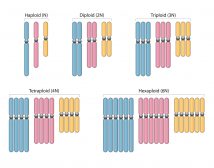Definition
noun, plural: allele frequencies
The frequency of an allele relative to that of other alleles of the same gene in a population.
Supplement
It is usually expressed as a proportion or a percentage, and describes the amount of genetic diversity at the individual, population, or species level.
Example: assuming that in a human population, there are 100 individuals. Since each of them would have two alleles for a particular character (one allele inherited from the father, the other allele from the mother), the total number of genes in this population is 200 (=100 x 2).
If out of the 100 individuals, there are 30 homozygous for the dominant trait (AA), 50 are heterozygous (Aa), and the remaining 20 are homozygous for the recessive trait (aa). Therefore, the total number of dominant genes in the population is (30 x 2) + (50 x1) = 110. is, (30 x 2) from the 30 homozygous (AA) plus (50 x1) from the 50 heterozygous (Aa) Thus, the frequency of the dominant trait (A) is (110/200) = 0.55 or 55%. Similarly, the total number of recessive genes in the population is (20 x 2) + (50 x 1) = 90. is, (20 x 2) from the 20 homozygous (aa) plus the (50 x 1) from the heterozygous (Aa) The frequency of the recessive trait (a) is (90/200) = 0.45 or 45%.
Variant: allelic frequency.
Synonym: gene frequency.
See also: gene pool, allele, population.
User Contributions / Comments:
- Chance events which may randomly alter allele frequencies are most likely to occur when population size is small.
(~Dlee7283)


